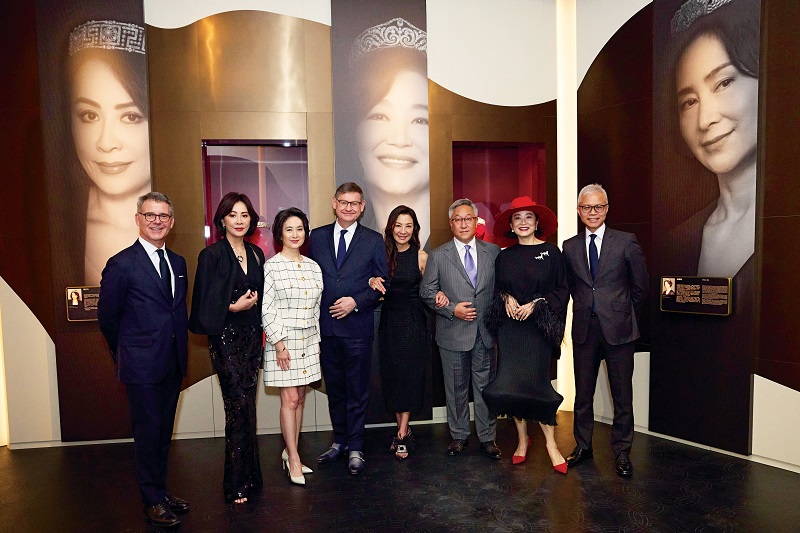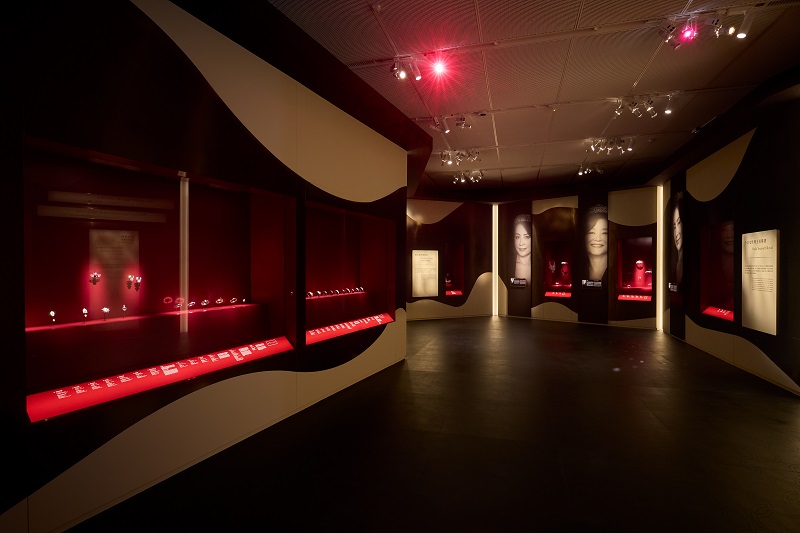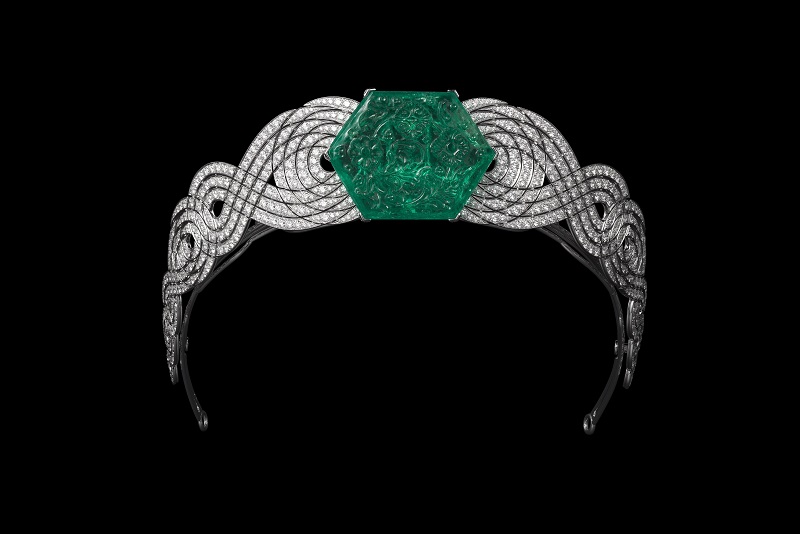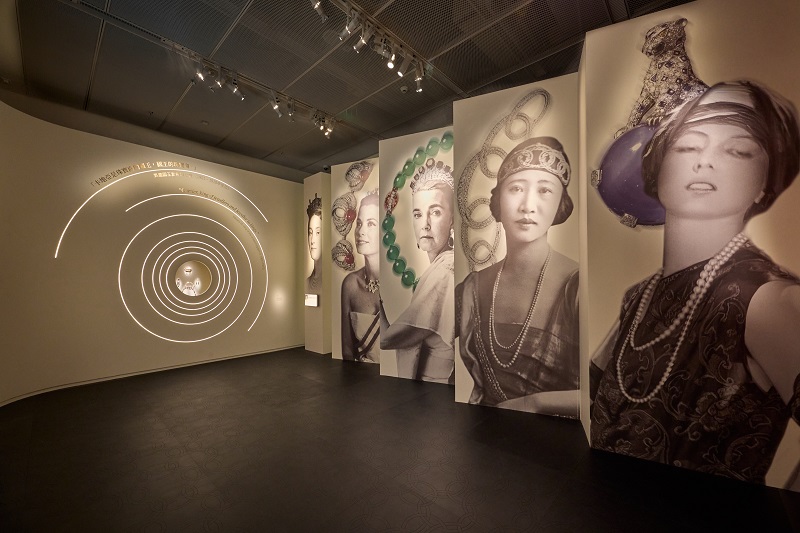
The Hindu necklace, originally designed in 1936, was altered in 1963 (All photos: Cartier)
“Good girls go to heaven, bad girls go everywhere” … wearing diamonds, pearls and every gem she fancies, if one may add to this sharp quote by American actress and playwright Mary Jane “Mae” West (1893-1980), known for her blunt sexuality and big pieces of jewellery.
West and legendary stars such as Gloria Swanson, Tallulah Bankhead, Merle Oberon, Marilyn Monroe, Catherine Deneuve, Grace Kelly and Elizabeth Taylor look out from film stills that take up one wall at Cartier and Women, on show at the Hong Kong Palace Museum (HKPM) until Aug 14.
There are four thematic sections to the display. The first, “Royal and Aristocratic Women: Elegance and Prestige”, takes visitors back to the 19th century to meet royals and the elite who had pieces of jewellery made for them for official occasions or special celebrations. Among them are a tiara with diamonds and pearls designed in 1907 for Princess Marie Bonaparte (1882-1962), and a Tutti Frutti necklace for Queen Alexandra of Great Britain (1844-1925).
“New Women: Breaking with Tradition” highlights how design advanced in step with those who sought to express themselves through objects and accessories, among other things, as emancipation led to empowerment and experimentation. Jeanne Toussaint (1887-1976), Cartier’s first female creative director, blazed a trail with stunning, revolutionary jewellery shaped by that famed “Toussaint taste”.
Her best-known creation is surely the Panthère brooch, designed in 1949 and acquired by the Duchess of Windsor, which redefined jewellery for women. This creature symbolic of boldness, independence and power has since become a signature Cartier motif.
01_vips_and_stars_pierre_carina_pansy_cyrille_michelle_nigel_brigitte_louis.jpg

“Inquisitive Women: Cross-cultural Inspirations” reflects how art from China and other parts of the world enlivened Cartier’s creations. Curious about what figured in the wardrobe of other women and eager to have them too, clients approached the house for novelties that they then used or wore with aplomb.
In 1920, Jeanne Paquin, France’s first major female couturier and a pioneer of the modern fashion business, acquired a brooch with “two dragons chasing a pearl”, a popular motif in Oriental art. In 1933, American socialite and style icon Barbara Hutton received a necklace made of jadeite — a gemstone valued by the Chinese as it denotes virtue, wisdom and beauty — as a wedding gift.
The first Cartier pendant with the yin-yang motif was created in 1919. The symbol has its roots in Taoist philosophy, which talks balance between two opposites and unity in life. Among the prized items in the collection of Mr and Mrs Louis Cartier is a 1928 Chinese-style vanity case that references a Kangxi period (1622-1722) porcelain dish.
Louis, credited for “creating the coherence” of the jewellery house, was one of the three grandsons of founder Louis-François. Reportedly impressed by Toussaint’s impeccable, universally-appreciated taste, he appointed her director of fine jewellery. On hindsight, the move was both foresight and a stroke of genius by the inherent aesthete who encouraged designers to experiment and innovate and was known for predicting and embracing trends.
Toussaint (nicknamed “the Panther”) delivered, with brooches, rings, bracelets, necklaces, watches, earrings, handbags, vanity cases and more. More importantly, her designs were an inspiration to socialites, stars and ordinary women who, buoyed by a new-found spirit of freedom and independence and a bolder attitude, lost little time translating their personality into what they wore. That changed jewellery from accessories that enhance external beauty to intimate belongings that reveal who they are and their aspirations.
hkpm_special_exhibition_gallery_13.jpg

Her Hindu necklace (1937) is an iconic piece that has become Cartier’s signature jewellery in the Tutti Frutti style. Made for stylish Daisy Fellowes, the French-American socialite and Singer heiress who was Paris correspondent for Harper’s Bazaar, it has gemstones carved in the shapes of berries, leaves and flowers.
In 2018, Toussaint recreated a 1931 necklace the house designed for the Maharaja Jam Sahib of Nawanagar. Named after her, it is the “star” in Ocean’s 8, a film in which all the leading roles are played by women.
“Influential Women: Glamorous Legends”, the final section explores the close relationship between Cartier jewellery and modern and contemporary female icons. Key pieces from the collections of important and well-known women — including Hong Kong billionaire businesswoman Pansy Ho and actresses Brigitte Lin and Carina Lau — sparkle and attract, both for their intricate designs and the impact and influence of those whom they dressed.
Altogether, the HKPM display brings out the close relationship between women, jewellery and fashion. Exhibits include pieces on loan from collectors, as well as items from the Cartier Collection. A project conceived in 1983, the collection, a witness to changes in social and fashion trends over time, has been shown in more than 30 cultural institutions worldwide, including the national Palace Museum in Beijing, in 2009 and 2019.
Cartier and Women features about 300 artefacts spanning almost 200 years, among them precious jewellery, timepieces, objects, accessories and archival records from the 19th century to the present day. It is the first major exhibition that foregrounds the unique role and influence of women in Cartier’s history. That it is organised and curated by HKPM, which opened last July in the West Kowloon Cultural District, with the support of the French maison founded in Paris in 1847, underscores how Chinese arts and culture have inspired the latter’s creations in terms of style, motif, material and craftsmanship.
hkpm_cartier_exhibition_16a.jpg

Cartier president and CEO Cyrille Vigneron says women are part of the company’s essence. It “appreciates and values character and personality and the exhibition is an exploratory journey into femininity as a whole, into human kind, its nature, condition and dreams”.
Director of image, style and heritage Pierre Rainero says Cartier and Women took more than three years, with many meetings held virtually. Hong Kong was among the last places to lift Covid-19 restrictions and there was relief all around when the exhibition opened as scheduled.
There has never been an exhibition specifically focused on the link between the maison and women and he was “a bit afraid”. He thinks the HKPM team did well in choosing important steps in the evolution of women all through the 20th century until now and “to illustrate that through big changes in jewellery”.
Securing private loans for show was a challenge. There is another, he adds.
“Jewellery speaks to the inner personality. What I like in jewellery is that permanent challenge of working with the very tough and solid materials to convey the idea of femininity, fluidity movement and sometimes very romantic ideas.” Many designers rise to the task, evident from the pieces on show at HKPM.
He also likes working with museums because of that push to always go further, with curators wanting to bring something new, and also with vigour, to visitors.
hkpm_special_exhibition_gallery_1.jpg

“As a jeweller, we have the same kind of motivation. We are pushed by the idea of perfection, of bringing something new [while] being faithful to ourselves and creating trust among our clients.”
Malaysian Oscar winner Tan Sri Michelle Yeoh was among the early visitors to Cartier and Women. At its launch, HKPM director Dr Louis Ng said it “underscores Hong Kong’s position as an East-meets-West centre for international cultural exchange, and highlights the museum’s global vision and innovative curatorial approach which emphasises rigorous research and scholarship”.
Various programmes will accompany the exhibition, from talks to documentaries about outstanding women in the creative industries, music and dance performances, and art-making workshops.
HKPM, which aims to facilitate dialogue among world civilisations, also presents more than 900 priceless treasures from the national Palace Museum and objects on loan from other collections, many of which have never been shown before. It is designed by Rocco Design Architects to “highlight a sense of history” and bring Chinese heritage to modern audiences. Besides browsing its nine galleries, visitors to the new cultural landmark can indulge in sweeping views of Victoria Harbour, the Hong Kong Island skyline, and Lantau Island.
This article first appeared on May 1, 2023 in The Edge Malaysia.


